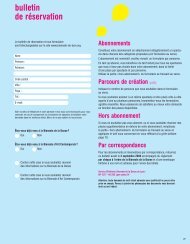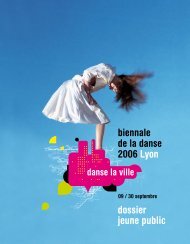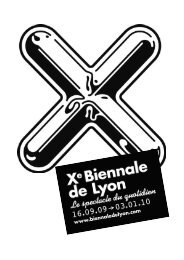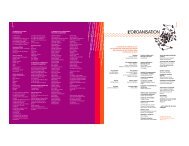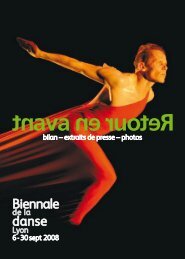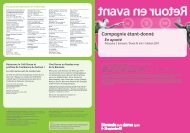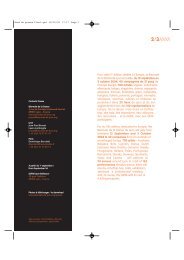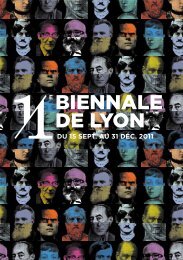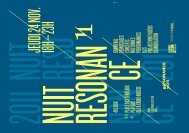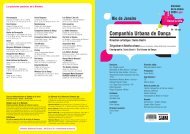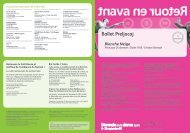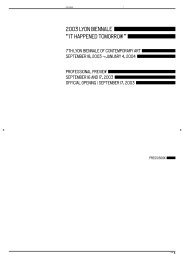Retour en Avant / Past Forward Biennale de la Danse Lyon - France
Retour en Avant / Past Forward Biennale de la Danse Lyon - France
Retour en Avant / Past Forward Biennale de la Danse Lyon - France
- No tags were found...
Create successful ePaper yourself
Turn your PDF publications into a flip-book with our unique Google optimized e-Paper software.
virevoltes et les bras <strong>de</strong> Carolyn Carlson ontimprimé les mémoires à travers ce solo, à<strong>la</strong> fois somme et exploration <strong>de</strong>s possibles.L’inspiration <strong>de</strong> <strong>la</strong> pièce est marquée parV<strong>en</strong>ise et par un élém<strong>en</strong>t biographique : <strong>la</strong>maternité <strong>de</strong> Carolyn Carlson. Cet événem<strong>en</strong>ta modifié <strong>en</strong> profon<strong>de</strong>ur sa consci<strong>en</strong>cedu mon<strong>de</strong> et <strong>de</strong> l’exist<strong>en</strong>ce. Cette perception<strong>de</strong>s horizons humains tisse <strong>la</strong> structure<strong>de</strong> Blue Lady, fascinante galerie <strong>de</strong> portraitsféminins qui embrasse l’espace d’une vie.De par leurs origines, Carolyn Carlson etTero Saarin<strong>en</strong> partag<strong>en</strong>t une forme d’âmefin<strong>la</strong>ndaise faite <strong>de</strong> distance au réel, d’imprévisibilitéet d’ironie. Ce rapport au réelparticulier fait partie intégrante <strong>de</strong> BlueLady. Alors que <strong>la</strong> pièce était <strong>en</strong>core <strong>en</strong>gestation, Carolyn Carlson a visité un hôpitalpsychiatrique véniti<strong>en</strong>. Elle s’est particulierem<strong>en</strong>tinspirée <strong>de</strong>s regards inquiets et <strong>de</strong>syeux emplis <strong>de</strong> méfiance d’un aliéné. C’estune <strong>de</strong>s dim<strong>en</strong>sions <strong>de</strong> l’œuvre qu’investiraTero Saarin<strong>en</strong>.Double vision / création2006 / solo interprété parCarolyn CarlsonDouble Vision est une r<strong>en</strong>contre transdisciplinaire<strong>en</strong>tre <strong>de</strong>ux artistes, <strong>la</strong> chorégrapheétoileCarolyn Carlson le jeune groupe <strong>de</strong>création Electronic Shadow, composé <strong>de</strong> l’architecteNaziha Mestaoui et du réalisateurYacine Aït Kaci, qui <strong>en</strong> faisant littéralem<strong>en</strong>tfusionner l’espace et l’image propos<strong>en</strong>t d<strong>en</strong>ouveaux types <strong>de</strong> perception. Consacrantcette r<strong>en</strong>contre, ce solo propose au publicune chorégraphie globale <strong>de</strong> <strong>la</strong> scène, dans<strong>la</strong>quelle le corps, celui <strong>de</strong> Carolyn Carlson,orchestre, dans un solo chorégraphique,un univers qui s’ét<strong>en</strong>d sur toute une scèneque <strong>la</strong> technologie a r<strong>en</strong>due vivante. Lascène <strong>de</strong>vi<strong>en</strong>t l’ext<strong>en</strong>sion du geste, il n’y aqu’une seule image, <strong>la</strong> scène elle-même ;<strong>la</strong> technologie est transpar<strong>en</strong>te, <strong>la</strong>issant <strong>la</strong>p<strong>la</strong>ce à l’émotion d’une perception décalée<strong>de</strong> <strong>la</strong> réalité. Le spectacle est une o<strong>de</strong> àl’imaginaire, une double vision <strong>de</strong> <strong>la</strong> réalité,un poème visuel et sonore sur <strong>la</strong> re<strong>la</strong>tivité<strong>de</strong> nos perceptions, une vision au-<strong>de</strong>là <strong>de</strong><strong>la</strong> vue. Le temps et l’espace se pli<strong>en</strong>t et sedépli<strong>en</strong>t dans un cycle éternel dont <strong>la</strong> duréedu spectacle est une tranche perceptible.Comm<strong>en</strong>t le passé peut-il <strong>de</strong>ssiner l’av<strong>en</strong>ir ?Nous sommes une nébuleuse <strong>de</strong> souv<strong>en</strong>irs à partir<strong>de</strong>squels nous <strong>de</strong>ssinons et construisons les œuvres<strong>de</strong> nos vies. Quand un événem<strong>en</strong>t a lieu, il ne se réduitpas à une seule chose : le passé, le prés<strong>en</strong>t, le futur ysont tous cont<strong>en</strong>us simultaném<strong>en</strong>t.Carolyn CarlsonL’ess<strong>en</strong>ce <strong>de</strong> l’art n’est pas <strong>de</strong> répondre à l’actualité.C’est d’être un catalyseur <strong>de</strong> <strong>la</strong> p<strong>en</strong>sée et du changem<strong>en</strong>t,et d’être un décl<strong>en</strong>cheur d’expéri<strong>en</strong>ces.David RobertsonInfos +Blue Lady / recréation pour <strong>la</strong> Bi<strong>en</strong>nalewww.ccn-roubaix.comCarolyn CarlsonCarolyn Carlson was born in California topar<strong>en</strong>ts of Finnish origin. She studied dance atthe San Francisco School of Ballet and at theUniversity of Utah, where she met Alwin Niko<strong>la</strong>isin 1965; for sev<strong>en</strong> years, she was an emblematicfigure of his New York-based company. Duringthis period she travelled the world, and in 1968won the best dancer award at the FestivalInternational <strong>de</strong> <strong>Danse</strong> in Paris. She th<strong>en</strong> joinedAnne Béranger’s company as soloist and choreographer;in 1972 her first piece, Rituel pour unrêve mort, was staged in the courtyard of thePapal Pa<strong>la</strong>ce in Avignon. In 1974, she met RolfLiebermann – a watershed mom<strong>en</strong>t. He broughther to the Opéra <strong>de</strong> Paris as star choreographer,and in 1975 invited her to run the opera house’stheatre research group (GRTOP). She createdmore than 25 works betwe<strong>en</strong> 1974 and 1980,including D<strong>en</strong>sity 21,5; The Architects; This, Thatand the Other; and Slow, Heavy and Blue. In1974, she began introducing the dancers to herimprovisation and composition technique. From1980-1985, she worked at the Teatro <strong>la</strong> F<strong>en</strong>icein V<strong>en</strong>ice, creating her emblematic solo BlueLady (1983), before returning to Paris and to hernew base, the Théâtre <strong>de</strong> <strong>la</strong> Ville (1985-1991).She th<strong>en</strong> had a two-year resid<strong>en</strong>cy in Fin<strong>la</strong>ndbefore taking over as artistic director of theCullberg Ballet in Stockholm (1994-1995).In betwe<strong>en</strong> choreographic activities, she experim<strong>en</strong>tswith “improvisation shows” in col<strong>la</strong>borationwith her favourite dancers (Larrio Ekson,Jorma Uotin<strong>en</strong>, Malou Airaudo) and musicians(Michel Portal, John Surman, R<strong>en</strong>é Aubry,Joachim Kuhn, Trilok Gurtu); and continues tocreate works for the repertoires of the ParisOpera Ballet (Signes) and the Bor<strong>de</strong>aux Opera(Hydrog<strong>en</strong> Jukebox), among others.While director of the dance section of the V<strong>en</strong>iceBi<strong>en</strong>nale (1999-2002), Carolyn created Parabo<strong>la</strong>(1999), Light Bringers (2000), J. Beuys Song(2001) and Writings on Water (2002). She hasalso foun<strong>de</strong>d a contemporary-dance aca<strong>de</strong>myand a festival. In 1999, she established the Atelier<strong>de</strong> Paris-Carolyn Carlson with backing fromthe City of Paris; it quickly became a leadingfacility for the professional training of dancersand for supporting the creation of new work.Since 2004, Carolyn Carlson has be<strong>en</strong> artisticdirector of the national choreography c<strong>en</strong>tre inRoubaix, northern <strong>France</strong>. In 2006 she receivedthe first Gold<strong>en</strong> Lion ever awar<strong>de</strong>d to a choreographerby the V<strong>en</strong>ice Bi<strong>en</strong>nale. Her stunninglymasterful dance, constantly striving for poetry, isinformed by her <strong>en</strong>counters with great creatorssuch as the composers Philip G<strong>la</strong>ss, R<strong>en</strong>é Aubry,Gavins Bryars, Kaija Saariaho and dancers includingLarrio Ekson, Jorma Uotin<strong>en</strong>, Marie-C<strong>la</strong>u<strong>de</strong>Pietragal<strong>la</strong>, Dominique Mercy and Tero Saarin<strong>en</strong>.Blue Lady / 1983, revisited in2008 / solo interpreted by TeroSaarin<strong>en</strong>Carolyn Carlson’s Blue Lady premiered on 11 October1983 at the Teatro La F<strong>en</strong>ice in V<strong>en</strong>ice. Thepiece caused a s<strong>en</strong>sation and was performed fort<strong>en</strong> years all over the world. Blue Lady markedthe blossoming of a major creative tal<strong>en</strong>t andperformer who had reached artistic maturity andachieved an incredible richness of movem<strong>en</strong>t.Music by R<strong>en</strong>é Aubry, <strong>en</strong>ormous V<strong>en</strong>etian blinds,a tree and swirling dresses and hats create apoetic <strong>en</strong>vironm<strong>en</strong>t for a f<strong>la</strong>mboyant dance.Carolyn Carlson’s spinning body and arm gestureshave left their mark on memories in a solowork that is both the sum and the explorationof possibilities. The inspirations for the pieceare V<strong>en</strong>ice and Carolyn Carlson’s <strong>en</strong>try intomotherhood. This ev<strong>en</strong>t profoundly changedher consciousness of the world and of exist<strong>en</strong>ce.Blue Lady is structured on her perception of humanhorizons; it is a fascinating gallery of femaleportraits spanning the space of one life.Through their origins, Carolyn Carlson and TeroSaarin<strong>en</strong> share a Finnish soul built on distancefrom reality, unpredictability and irony. Thisdistinctive re<strong>la</strong>tionship with reality forms anintegral part of Blue Lady. Wh<strong>en</strong> the piece wasat the p<strong>la</strong>nning stage, Carolyn Carlson visited apsychiatric hospital in V<strong>en</strong>ice and was especiallyinspired by the anxiety and suspicion she sawin the eyes of the m<strong>en</strong>tally ill pati<strong>en</strong>ts. This is adim<strong>en</strong>sion of the work that Tero Saarin<strong>en</strong> willconc<strong>en</strong>trate on.Double Vision / 2006 creation /solo interpreted by CarolynCarlsonDouble Vision is a cross-disciplinary <strong>en</strong>counterbetwe<strong>en</strong> two artists: star choreographer CarolynCarlson and young creative p<strong>la</strong>tform ElectronicShadow, comprising architect Naziha Mestaouiand film director Yacine Aït Kaci, who propos<strong>en</strong>ew types of perception by literally fusing spaceand imagery. This solo is the record of their<strong>en</strong>counter. It offers the audi<strong>en</strong>ce a choreographythat <strong>en</strong>compasses and integrates dancer andstage; Carolyn Carlson’s body orchestrates aworld that stretches right across a stage broughtto life by technology. The stage becomes the ext<strong>en</strong>sionof gesture; there is only one image, thestage itself; the technology is transpar<strong>en</strong>t, givingway to the emotion of a disjointed perceptionof reality. The show is an o<strong>de</strong> to the imaginedworld, a double vision of reality, a poem ofvision and sound about the re<strong>la</strong>tivity of our perceptions,a vision beyond sight. Time and spacefold and unfold in an eternal cycle, of which thel<strong>en</strong>gth of the show is a perceptible period.How can the past shape the future?We are a bank of memories from which we draw andconstruct our life works. There isn’t just one thinghapp<strong>en</strong>ing; past pres<strong>en</strong>t future - all are contained inthis simultaneity of ev<strong>en</strong>ts.Carolyn CarlsonThe i<strong>de</strong>a of the arts is not to be the response to whatis going on. It’s to be a catalyst for thought andchange and an op<strong>en</strong>ing up of experi<strong>en</strong>ce.David RobertsonExtra info:Blue Lady / recreated for the Bi<strong>en</strong>nalewww.ccn-roubaix.com15



